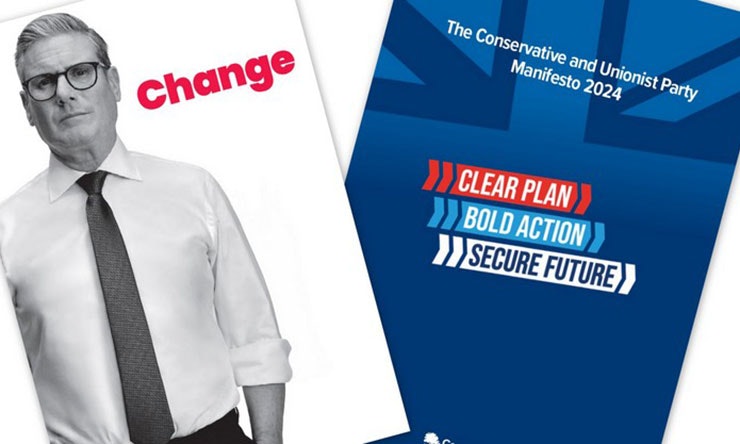Manifesto showdown: are Labour or Conservatives better for bikes?
By Ben Purvis
Motorcycle Journalist
13.06.2024
The launch of Labour’s manifesto means that every major party has now set out its stall for July’s General Election so we can finally draw direct comparisons between them when it comes to all matters motorcycling.
Labour manifesto
With every major poll indicating a Labour win, and potentially a landslide, it’s Labour’s manifesto that’s arguably the most important as it lays out the most likely policies that will be enacted over the next five years. The Labour manifesto clocks in at 136 pages and over 25,000 words, so how many times do motorcycles get a mention?
The answer is… None. Search as you might, you won’t find the words ‘motorcycle’, ‘motorcyclist’, ‘motorbike’ or any other variation on the theme in there. There are a couple of pages on transport policy, but while drivers and cyclists get a namecheck, we’re lumped in there as ‘other road users.’
Conservative manifesto
In comparison, the Conservative manifesto released a few days earlier, at just 78 pages but with more tightly-packed text to hit the 27,000-word mark, managed to include two key promises specifically for motorcyclists. The first is to open all bus lanes in the country to motorcycles, eliminating the can-you-or-can’t-you confusion of the status quo, and the second is to reform motorcycle licensing. The manifesto doesn’t give more detail on that second point, but it’s something the motorcycle industry has been calling for following the clear failure of the current costly, confusing and complicated licensing regime – imposed by the EU but not repealed following Brexit – to improve safety despite imposing unnecessary barriers to riding.
That’s not to say there’s nothing in Labour’s manifesto for riders to celebrate, though. It makes specific mention of ‘the potholes cratering our roads’ as ‘a visible sign of the decline after 14 years of Conservative rule.’ Labour promises extra money to fix potholes, over and above the £8.3 billion promised by the Tories, with the aim of fixing ‘an additional one million potholes across England in each year of the next parliament’. That will be funded by putting the brakes on the costly plans for the A27 bypass.
Although not directly impacting bikes, Labour also intends to restore the previous schedule to phase-out the sale of new non-zero emission cars by 2030 – a plan that the Conservative government last year pushed back to 2035 – and that might be an indication that ideas for motorcycles to follow suit, which have been in limbo since the end of a 2022 consultation, might also be revived. Labour plans to accelerate the roll-out of more EV charge points to support this schedule – something that owners of electric bikes will also benefit from.
Also potentially benefiting bikes are Labour plans to ‘support drivers by tackling the soaring cost of car insurance.’ While bikes aren’t mentioned and we’ve yet to see detail of how Labour will achieve that goal, it’s likely that any crackdown on car insurance could also impact the prices of motorcycle policies.
The Conservative manifesto, by contrast, makes a specific target of appealing to road users, promising to stop road pricing and reverse the ULEZ expansion in London and to ensure that any new 20mph zones or Low Traffic Neighbourhoods would be subject to local referendums before being introduced.
From an industry perspective, Labour’s manifesto includes a pledge to invest £1.5 billion in the automotive industry, with a focus on electrification, some of which could potentially find its way to the bike industry.
What about the other parties?
While polls might indicate that only Labour or the Conservatives are genuinely in with a shot of forming the next government, and Labour is well ahead at the moment, what do the other parties promise when it come to bikes and roads?
The Lib Dem manifesto, like Labour’s, promises to end ‘unfair’ insurance costs for motorists, as well as aiming to cut petrol prices – particularly in rural areas by expending Rural Fuel Duty Relief that compensates fuel retailers in remote areas to cover some of the additional costs they face and bring prices down for customers. Also like Labour, the Lib Dems plan to reintroduce the 2030 cut-off for non-zero emission new car sales, while bringing back the plug-in car grant to help the transition to EVs. The Lib Dems also want to increase the number of charge points, both in residential areas and at service stations, while cutting VAT on public chargers to 5% to reduce costs and ensuring all public chargers can be used simply with a bank card rather than requiring phone apps.
It won’t come as any surprise to hear that the Green Party manifesto’s focus on motorists is to push them away from roads and onto public transport, as well as radical plans for electrification of those that remain on the road. The Greens want to see all petrol and diesel vehicles replaced by EVs within a decade and would end the sale of new petrol or diesel vehicles (presumably including bikes) as soon as 2027. They would also make road tax proportional to the weight of a vehicle, while making 20mph limits the norm in built-up areas.
Diametrically opposing the plans in the Green Party manifesto, there are the promises of Reform. Reform wants to completely scrap the plan to ban petrol and diesel cars from sale, as well as eliminating requirements for manufacturers to make any proportion of their sales electric. It also wants to end ULEZ and Low Traffic Neighbourhoods.
While early polls predict that none of those parties have a chance of being in government after the election, the number of MPs each has will have an impact on how they can influence the action of the ruling party during the next parliament.
If you’d like to chat about this article or anything else biking related, join us and thousands of other riders at the Bennetts BikeSocial Facebook page.
